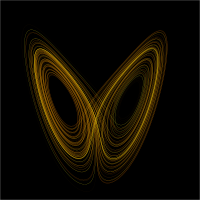
Photo from wikipedia
A generalized third-order autonomous Duffing–Holmes system is proposed and deeply investigated. The proposed system is obtained by adding a parametric quadratic term to the cubic nonlinear term of an existing… Click to show full abstract
A generalized third-order autonomous Duffing–Holmes system is proposed and deeply investigated. The proposed system is obtained by adding a parametric quadratic term to the cubic nonlinear term of an existing third-order autonomous Duffing–Holmes system. This modification allows the system to feature smoothly adjustable nonlinearity, symmetry, and nontrivial equilibria. A particular attention is given to the effects of symmetric and asymmetric nonlinearity on the dynamics of the system. For the specific case of , the system is symmetric and interesting phenomena are observed, namely, coexistence of symmetric bifurcations, presence of parallel branches, and the coexistence of four (periodic-chaotic) and six (periodic) symmetric attractors. For , the system loses its symmetry. This favors the emergence of other behaviors, such as the coexistence of asymmetric bifurcations, involving the coexistence of several asymmetric attractors (periodic-periodic or periodic-chaotic). All these phenomena have been numerically highlighted using nonlinear dynamic tools (bifurcation diagrams, Lyapunov exponents, phase portraits, time series, frequency spectra, Poincare section, cross sections of the attraction basins, etc.) and an analog computer of the system. In fact, PSpice simulations of the latter confirm numerical results. Moreover, amplitude control and synchronization strategies are also provided in order to promote the exploitation of the proposed system in engineering.
Journal Title: Complexity
Year Published: 2020
Link to full text (if available)
Share on Social Media: Sign Up to like & get
recommendations!